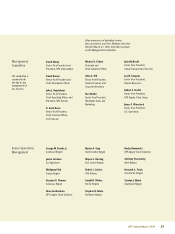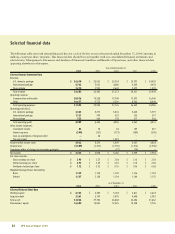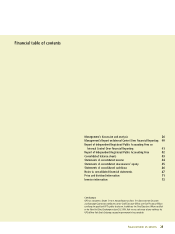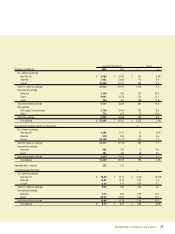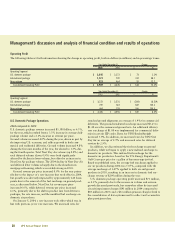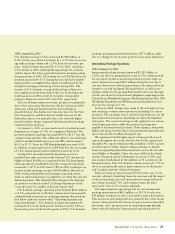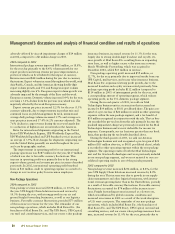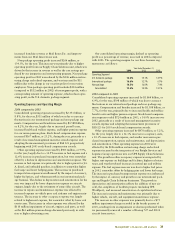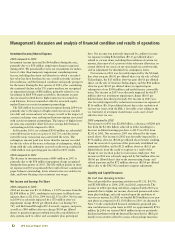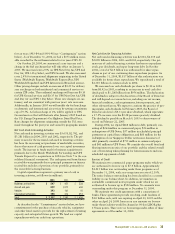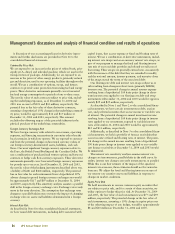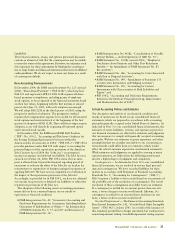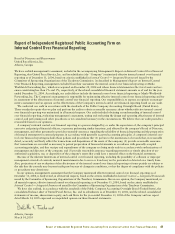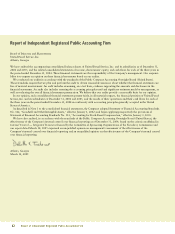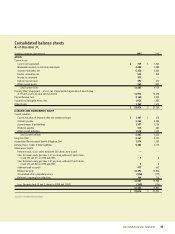UPS 2004 Annual Report Download - page 35
Download and view the complete annual report
Please find page 35 of the 2004 UPS annual report below. You can navigate through the pages in the report by either clicking on the pages listed below, or by using the keyword search tool below to find specific information within the annual report.
Management’s discussion and analysis 33
for tax years 1983-84 and 1991-98 (see “Contingencies” section
below). As of December 31, 2004, we had a $371 million receiv-
able recorded for the settlement related to tax years 1985-90.
On October 28, 2004, we announced a rate increase and a
change in the fuel surcharge that will take effect on January 3,
2005. We increased rates 2.9% on UPS Next Day Air, UPS 2nd
Day Air, UPS 3 Day Select, and UPS Ground. We also increased
rates 2.9% for international shipments originating in the United
States (Worldwide Express, Worldwide Express Plus, UPS
Worldwide Expedited and UPS International Standard service).
Other pricing changes include an increase of $0.25 for delivery
area surcharge on both residential and commercial services to
certain ZIP codes. The residential surcharge will increase $0.10
for UPS Ground services and $0.35 for UPS Next Day Air, UPS
2nd Day Air and UPS 3 Day Select. These rate changes are cus-
tomary, and are consistent with previous years’ rate increases.
Additionally, in January 2005 we will modify the fuel surcharge
on domestic and international air services by setting a maximum
cap of 9.5%. A fuel surcharge of 2% will be applied to UPS
Ground services that will fluctuate after January 2005 based on
the U.S. Energy Department’s On-Highway Diesel Fuel Price.
Rate changes for shipments originating outside the U.S. were
made throughout the past year and varied by geographic market.
Net Cash Used In Investing Activities
Net cash used in investing activities was $3.638, $2.742, and
$3.281 billion in 2004, 2003 and 2002, respectively. The pri-
mary reason for the increased cash used in investing activities
has been the increasing net purchases of marketable securities,
due to the excess of cash generated over our capital investment
needs. The increase in funds used for business acquisitions is
primarily due to the Menlo Worldwide Forwarding and UPS
Yamato Express Co. acquisitions in 2004 (see Note 7 to the con-
solidated financial statements). The cash generated from finance
receivables was primarily due to principal payments on finance
receivables and sales of portions of our portfolio, primarily in
the receivable factoring business.
Capital expenditures represent a primary use of cash in
investing activities, as follows (in millions):
2004 2003 2002
Buildings and facilities$547 $451 $528
Aircraft and parts 829 1,019 638
Vehicles 393 161 41
Information technology 358 316 451
Total $ 2,127 $ 1,947 $ 1,658
As described in the “Commitments” section below, we have
commitments for the purchase of aircraft, vehicles, equipment
and other fixed assets to provide for the replacement of existing
capacity and anticipated future growth. We fund our capital
expenditures with our cash from operations.
Net Cash Used In Financing Activities
Net cash used in financing activities was $2.014, $2.110 and
$2.090 billion in 2004, 2003 and 2002, respectively. Our pri-
mary use of cash in financing activities has been to repurchase
stock, pay dividends, and repay long-term debt. In October
2004, a total of $2.0 billion was authorized for share repur-
chases as part of our continuing share repurchase program. As
of December 31, 2004, $1.817 billion of this authorization was
available for future share repurchases. We repurchased a total of
$1.310 billion of common stock in 2004.
We increased our cash dividends per share to $1.12 in 2004
from $0.92 in 2003, resulting in an increase in total cash divi-
dends paid to $1.208 billion from $956 million. The declaration
of dividends is subject to the discretion of the Board of Directors
and will depend on various factors, including our net income,
financial condition, cash requirements, future prospects, and
other relevant factors. We expect to continue the practice of pay-
ing regular cash dividends. In February 2005, the Board of
Directors declared a $0.33 per share dividend, which represents
a 17.9% increase over the $0.28 previous quarterly dividend.
The dividend is payable on March 9, 2005 to shareowners of
record on February 22, 2005.
During 2004, we repaid $468 million in debt, primarily con-
sisting of $264 million in commercial paper, $56 million in
redemptions of UPS Notes, $57 million in scheduled principal
payments on capital lease obligations, and $60 million for the
redemption of our Singapore Dollar notes issue. Issuances of
debt primarily consisted of $735 million in commercial paper
and $41 million in UPS Notes. We consider the overall fixed and
floating interest rate mix of our portfolio and the related overall
cost of borrowing when planning for future issuances and non-
scheduled repayments of debt.
Sources of Credit
We maintain two commercial paper programs under which we
are authorized to borrow up to $7.0 billion. Approximately
$1.015 billion was outstanding under these programs as of
December 31, 2004, with an average interest rate of 2.10%.
The entire balance outstanding has been classified as a current
liability in our balance sheet. In addition, we maintain an
extendable commercial notes program under which we are
authorized to borrow up to $500 million. No amounts were
outstanding under this program at December 31, 2004.
We maintain two credit agreements with a consortium of
banks. These agreements provide revolving credit facilities of
$1.0 billion each, with one expiring on April 21, 2005 and the
other on April 24, 2008. Interest on any amounts we borrow
under these facilities would be charged at 90-day LIBOR plus
15 basis points. There were no borrowings under either of these
agreements as of December 31, 2004.


